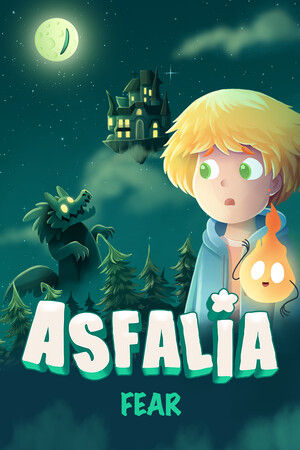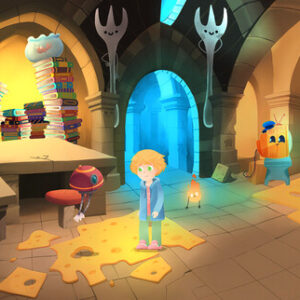Asfalia: Fear Free Download Direct Steam-Cracked
Asfalia: Fear employs a non-linear narrative structure that invites players to make significant choices that shape both the gameplay and the story’s outcome. Unlike traditional point-and-click games, where the narrative unfolds in a predetermined sequence, Asfalia: Fear offers players the freedom to make decisions that impact character relationships, plot progression, and ultimately the fate of the protagonists.
The Power of Player Agency
In Asfalia: Fear, the choices players make are not only moral decisions but also emotional ones. For example, a seemingly simple decision, such as comforting a character during a vulnerable moment, can alter the flow of the story. These decisions ripple through the gameplay, affecting both minor interactions and major plot points. This structure makes each playthrough unique, as the emotional tone of the game can shift drastically based on the player’s choices.
This level of player agency is further emphasized by the game’s emotional consequences. When players choose to avoid confronting difficult emotional moments, they may cause certain characters to regress or develop differently. On the other hand, when players actively engage with the emotional struggles of the characters, they help them grow and progress.
The dialogue options are designed in such a way that each response feels authentic to the characters’ emotional state. The game challenges players to consider not just the immediate consequences of their actions but also the long-term impact on relationships and self-discovery. It’s a delicate balance of empathy, decision-making, and understanding.
Emotional Weight of Choices
The game also subverts traditional notions of choice by often presenting players with morally grey decisions. Instead of the usual “good” or “bad” options, players are forced to grapple with the complexities of real-life dilemmas. This makes the stakes of every decision feel much more personal. Players are constantly faced with the question: What is the right thing to do when there’s no easy answer? The narrative’s structure reinforces this complexity by ensuring that each decision is meaningful and resonates emotionally with the characters involved.
These choices are integral to the core theme of Asfalia: Fear—embracing and confronting fear. The fear of making the wrong choice, the fear of emotional vulnerability, and the fear of failure are constant undercurrents throughout the game. As players guide the characters through these moments, they are also forced to confront their own fears and uncertainties.
61. Game Design and Mechanics
The game design of Asfalia: Fear takes a novel approach to the traditional point-and-click genre by integrating innovative mechanics that enhance the emotional narrative. From interactive puzzles to innovative dialogue systems, the gameplay is designed to keep players engaged while reinforcing the themes of the story.
Interactive Puzzles and Emotional Symbolism
A defining feature of Asfalia: Fear is its use of interactive puzzles that are intricately tied to the characters’ emotional states. These puzzles are not just obstacles for players to solve—they serve as metaphors for the emotional challenges the characters face. For example, one of the puzzles involves piecing together broken memories, symbolizing a character’s journey toward healing from trauma. Another puzzle might involve navigating a dark and foreboding environment, mirroring the character’s struggle with fear and uncertainty.
The puzzles are cleverly designed to require players to think not only logically but emotionally. They often involve decision-making that aligns with the characters’ personal growth, allowing players to feel as though they are directly influencing the characters’ emotional states. This integration of puzzle-solving with narrative progression makes the gameplay feel more immersive and emotionally resonant.
Unique Dialogue System
The dialogue system in Asfalia: Fear is another standout feature. Unlike traditional dialogue trees, where players simply choose between a set of predefined responses, Asfalia: Fear offers a dynamic system that takes into account the characters’ emotional states and past interactions. Characters remember what players say, and their responses change depending on the choices made earlier in the game.
This system creates a sense of continuity and emotional depth that enhances the player’s connection with the characters. It also allows for a deeper level of roleplaying, as players can shape the relationships in a way that feels authentic to their playstyle. Whether players choose to be compassionate, tough, or distant, the characters’ reactions reflect the emotional tone of the dialogue.
The emotional complexity of the dialogue system is further enhanced by the fully voiced performances of the characters. Professional voice actors bring the dialogue to life, infusing each line with emotional depth and nuance. This adds another layer of immersion, making players feel as though they are truly interacting with living, breathing characters.
62. Visuals and Art Direction
The art direction of Asfalia: Fear is an integral part of the game’s storytelling. The visuals are not just aesthetically pleasing but also serve to reinforce the game’s themes of fear, growth, and self-discovery. The developers have carefully crafted each environment to reflect the emotional tone of the narrative, using visual cues to guide players through the characters’ psychological landscapes.
Environmental Storytelling
Every environment in Asfalia: Fear tells a story. From the dimly lit forests to the eerie, abandoned buildings, the world is designed to evoke emotions of unease, mystery, and anticipation. The use of light and shadow is particularly effective in conveying the emotional atmosphere of the game. Dark, oppressive spaces are often associated with the characters’ fears and anxieties, while brighter, more vibrant environments represent moments of hope and healing.
The environments are also symbolic. The game’s world is constructed in such a way that it feels like a manifestation of the characters’ inner worlds. For example, a character who is struggling with feelings of isolation might find themselves in a vast, empty space, reflecting their emotional state. On the other hand, a character who is learning to trust others might encounter a warm, welcoming environment filled with light and color.
This use of environmental storytelling helps players connect with the characters’ emotional journeys in a visceral way. As players move through the game, they are not just solving puzzles and making choices—they are experiencing the characters’ fears, hopes, and growth in a deeply immersive manner.
Character Design and Symbolism
The character designs in Asfalia: Fear are also noteworthy for their symbolic significance. Each character’s appearance is designed to reflect their personality, emotional state, and journey throughout the game. Laika, for example, is depicted with strong, bold features that evolve throughout the game as she grows into a leader. Lexie’s design, on the other hand, is softer and more understated, symbolizing her quiet internal struggle.
The characters’ outfits, expressions, and even the way they move are all carefully crafted to reflect their emotional arc. The attention to detail in the character designs helps players form a deeper emotional connection with each protagonist. It also reinforces the game’s themes of growth and self-discovery, as players can visually see how the characters change over time.
63. Music and Sound Design
The music and sound design of Asfalia: Fear are integral components of the emotional atmosphere of the game. The soundtrack is carefully composed to match the game’s narrative highs and lows, ensuring that the player’s emotional engagement is heightened with every scene.
Emotional Impact of the Soundtrack
The soundtrack is composed of haunting, minimalist melodies that underscore the characters’ internal struggles. During moments of fear or uncertainty, the music becomes discordant and unsettling, reflecting the chaos and turmoil within the characters’ minds. Conversely, during moments of clarity or emotional breakthrough, the music becomes more harmonious and uplifting, symbolizing the characters’ growth.
One of the most powerful aspects of the soundtrack is its ability to evoke specific emotions in players. Whether it’s the tension of a moment of fear or the relief of emotional resolution, the music amplifies the emotional resonance of each scene. This immersive use of music is a testament to the power of sound design in video games and its ability to enhance the storytelling experience.
Sound Design as an Emotional Tool
In addition to the music, the game’s sound design is used to great effect to enhance the atmosphere. The sounds of footsteps, whispers, and distant noises are carefully placed throughout the game to build tension and add to the sense of fear and unease. The sound design is not just about creating a realistic environment—it’s about manipulating the player’s emotional response to the game world.
For example, when a character is in a particularly vulnerable state, the sound design becomes more subtle, with faint echoes and whispers creating a sense of isolation. This makes the player feel more immersed in the character’s emotional journey, as if they are experiencing the fear and uncertainty firsthand.
64. Emotional Depth and Immersion
Asfalia: Fear stands out from other games in its genre due to its deep emotional resonance. The game’s focus on fear, personal growth, and healing makes it a profoundly immersive experience for players. As players guide the characters through their emotional struggles, they are not just participants in a story—they become part of the emotional journey themselves.
Creating Emotional Connections with Players
One of the game’s most impressive feats is its ability to create emotional connections between the player and the characters. The game does this through its richly developed narrative, deeply flawed but relatable characters, and emotionally charged gameplay mechanics. Players find themselves invested in the characters’ struggles and triumphs, not just because of the plot, but because of how real the characters feel.
The emotional depth of the game also makes it a valuable tool for self-reflection. As players navigate the characters’ emotional landscapes, they are often forced to confront their own fears and vulnerabilities. The game’s exploration of fear as a transformative force encourages players to think about their own emotional growth and resilience. It challenges them to embrace their fears, rather than avoid them, and to recognize that emotional pain is an inevitable part of the human experience.
SYSTEM REQUIREMENTS
- OS *: Windows 7 or later
- Processor: Any 64 bits processor
- Memory: 2 GB RAM
- Graphics: Any
- Storage: 4 GB available space
Game Insights
- Genre: Adventure, Indie
- Developer: Funtomata
- Platform: PC
- Game Size: 1 GB
- Released By: SKIDROW emu
- Version: Build 17003252 | Full Version
- Full PC Games


